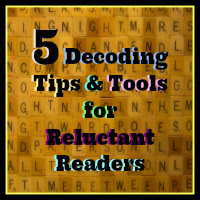What IS Decoding?
The term decoding refers to the process of translating a printed word into a sound. To demonstrate, please read the following words aloud: dog, table, jump. This is an example of decoding regular words and is sometimes called word identification skill. Regular words are commonly used words, i.e., words frequently found in printed material.
To further illustrate the skill of decoding, please read the following words, aloud: blud, wight, frish. This is an example of decoding non-words (or decoding pseudo-words) and is sometimes called word attack skill. Pseudo-words are pronounceable based on phonics rules but are not real words. A highly similar task involves asking students to read words that they have never seen before—i.e., unfamiliar or new vocabulary words.
How can we tell if a student is proficient at decoding? The two most common tests of decoding skill are to ask students to:
1. Translate printed, regular words into sounds (i.e., word identification skill) and
2. Translate printed pseudo-words or printed unfamiliar words into sounds (i.e., word attack skill).
We can measure a student's decoding accuracy—by counting the number of times the student makes the correct sound—or the student's decoding speed (also called efficiency)—by counting the number of correctly decoded words per minute. As one might expect, high proficiency is indicated by a high rate of accuracy and/or speed.
However, significant problems result when a student's decoding skill level is low or poorly developed. When he cannot breakdown words into the sound of each phoneme, fluency, rate, tracking and other skills also suffer.
There are a variety of tips, strategies and tools available today to help improve a reader's decoding skill. We hope the following 5 resources will help you and the readers you serve to get started in the right way. In the process, you will also be promoting more in the way of phonemic awareness at the same time. The end result may very well be that reading reluctance could turn into reading motivation for the individuals you help.
Tips to Help with Decoding
1. Use individual colored markers to highlight each phoneme (or syllable, if that is the phonics method you employ) in a word. Try a different color for each phoneme. For optimum results, consistently use the same color for the same phoneme from one activity to another. This may best be accomplished by using a key or legend shared with the reluctant reader you are assisting.
2. If a variety of colored markers are not available, box out each phoneme or syllable with a pencil or pen to show the beginnings and endings of words, blends or other phonemes. As in the above method, this also helps break down a word or phrase into chunks or manageable units for a challenged or reluctant reader.
3. Cover parts of words and phrases that do not need decoding at the moment. So much of the reluctance of a challenged reader is the feeling of overwhelm by just too many letters, words or lines of text viewed simultaneously or in rapid succession. This covering can be achieved simply with the aid of a one's finger.
Tools to Help with Decoding
1. Use a ruler, index card or the low-tech Reading Focus Cards (Patent 7,565,759), inexpensive tools for challenged readers, to easily breakdown or decode words, phrases and lines of text on physical pages, worksheets or other documents. Both the colored reading window and/or the notch at the top of the focus cards can be used for this decoding process.
Use of the Reading Focus Cards' reading window (yellow filter option) for decoding:
Use of the Reading Focus Cards' reading notch for decoding:
2. Use the digital Reading Focus Cards desktop app (Patent 8,360,779) for Macs and Windows PCs, an innovative and fully customizable application for challenged readers to easily breakdown or decode words, phrases and lines of text on digital pages or documents---whether online or offline.
Here are just 2 decoding steps out of a possible 7 steps to break down the word happiness with this Reading Focus Cards desktop app:
Sources
What is Decoding? article by R.E. Mayer, education.com
https://www.education.com/reference/article/what-is-decoding-reading/
For more information about assistive technologies for challenged readers, please visit:
www.FocusandRead.com Tools for struggling readers of all ages!
www.BrennanInnovators.com Info & support for struggling readers
314-892-3897
Image sources:
Fingernail photo: Mr. Barlow's Blog at https://mrbarlow.wordpress.com/2008/10/19/why-do-you-get-white-spots-on-your-fingernails/
Other images: Brennan Innovators, LLC at www.focusandread.com








No comments:
Post a Comment